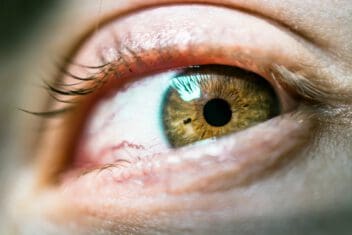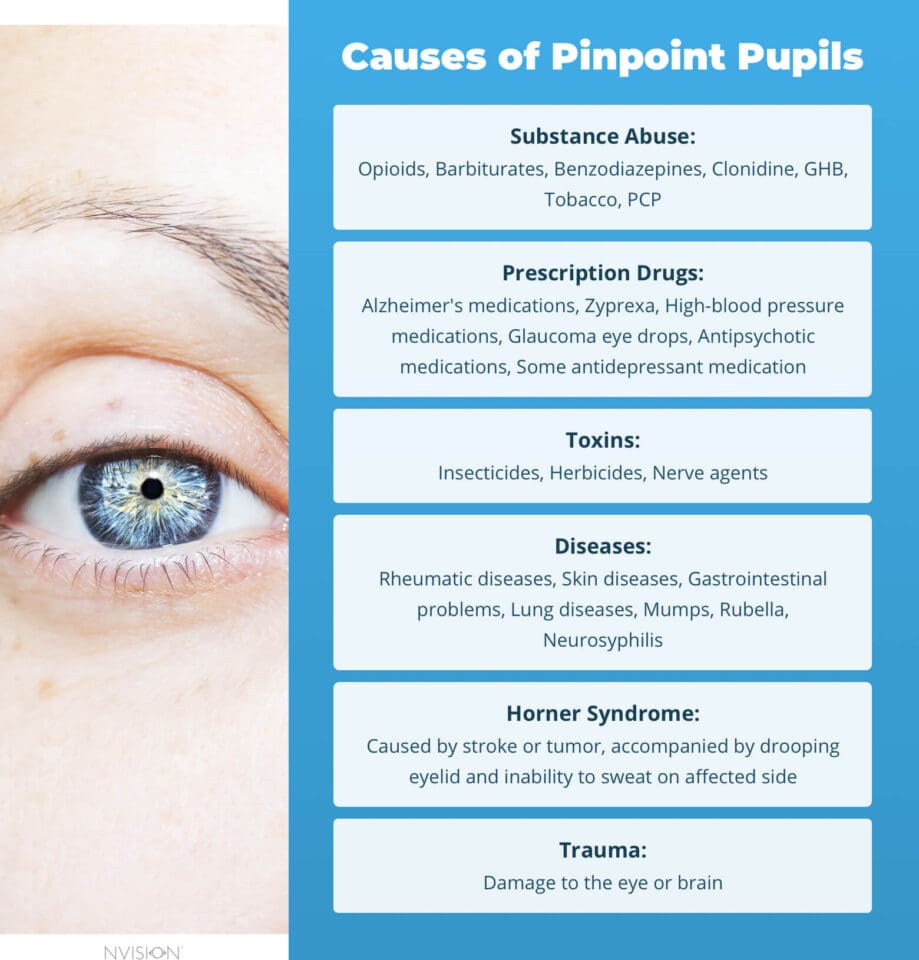Why Do I Have Pinpoint Pupils? 6 Causes
Home / Eye Health and Preventive Care /
Last Updated:
There are several reasons that your pupils might constrict, leading to “pinpoints” that are two millimeters or smaller. Small pupils can be due to bright light, an emotional response, or looking at something far away.
There are six health risks that can cause pinpoint pupils, or miosis. These include substance abuse with pinpoint pupil causing drugs, prescription drugs, environmental toxins, diseases, Horner syndrome, and trauma to the eye or brain.
Table of Contents
There is no direct treatment for pinpoint pupils. The issue can be a sign of an underlying health problem that requires medical attention. If you suddenly develop pinpoint pupils, make an appointment with your doctor or go to the emergency room.
What Are Pinpoint Pupils?

Your pupils will change size in different lighting conditions, allowing different amounts of light onto your retina so you can still see. Whether it is a bright summer day or you are in a dimly lit restaurant, healthy eyes will adjust to these conditions. There are other factors that can influence the size of your pupils too.
The muscles in your iris pull your pupil closed or allow it to open for several normal, healthy reasons. You could have pinpoint pupils, or miosis, because of several conditions. For example, you could be in bright light, so your pupils will be smaller. They may constrict if you look at something far away, or they could become smaller because of an emotional response.
You deserve clear vision. We can help.
With 135+ locations and over 2.5 million procedures performed, our board-certified eye surgeons deliver results you can trust.
Your journey to better vision starts here.
These are temporary responses, and miosis will adjust as conditions around you change. Pupils that are less than two millimeters are pinpoint pupils, or miosis.
Pinpoint pupils can also indicate that something is wrong with your health. You may be on a drug that constricts your pupils too much; you may have a nerve or head injury; or there could be a problem inside your eye.
6 Causes of Pinpoint Pupils

If there is no environmental or emotional cause associated with pinpoint pupils, another underlying cause could make your pupils change size and stay there. Unfortunately, several of these can indicate health problems or danger.
1. Substance Abuse
Pinpoint pupils and drugs are often linked. Opioids are the most common drug associated with pinpoint pupils. Abusing heroin, fentanyl, or prescription painkillers can cause your pupils to constrict. Pinpoint pupils smaller than two millimeters also indicate an opioid overdose, which is life-threatening.
These other drugs can cause pinpoint pupils:
- Barbiturates, benzodiazepines, or other sedatives (when abused)
- Clonidine
- GHB
- Tobacco or nicotine
- PCP (angel dust)
2. Prescription Drugs
Some prescription drugs (and even over-the-counter medications) can affect the normal functioning of your eyes and lead to pinpoint pupils. Some of known pinpoint pupil causing drugs are:
- Alzheimer’s medications, referred to as cholinergic drugs, including Pyridostigmine
- Zyprexa
- Hypertension (high blood pressure) medications, including clonidine and tetrahydrozline
- Prescription eyedrops, usually for treating glaucoma
- Some antipsychotic medications, called neuroleptics, including Haloperidol and quetiapine
- Some antidepressant medications, called noradrenergic serotonergic antidepressants, including Mirtazapine
If any medications you take are suspected of causing changes to your pupils, this should trigger an immediate review of all the medications you take and whether any one, or any combination, is harming you.
3. Toxins
Some types of insecticides, herbicides, and nerve agents can cause pinpoint pupils. You may not realize you have been exposed to such a high dose of these chemicals due to cognitive side effects, but pupil size can be an indicator for medical professionals.
4. Diseases
Infections that damage the iris, or the middle part of your eye, can cause your pupil to constrict. This condition is called anterior uveitis.
These diseases are associated with miosis:
- Rheumatic diseases like rheumatoid arthritis
- Skin diseases
- Gastrointestinal problems
- Lung diseases
- Mumps
- Rubella
- Neurosyphilis
5. Horner Syndrome
This is a specific medical condition caused by a stroke or a tumor in the brain that damages your brain stem, specifically a type of nerve called the sympathetic nerve.
Pinpoint pupil in one eye is one of the three primary symptoms. The other two are:
- Drooping upper eyelid on the affected side.
- Inability to sweat on the affected side.
6. Trauma
Damage to the eye or brain can cause miosis in one or both eyes, which is typically permanent.
How Are Pinpoint Pupils Managed or Treated?

Pinpoint pupils on their own are not inherently dangerous, although you could have a hard time seeing in normal light if you take a medication with miosis as a side effect. However, pinpoint pupils can indicate an underlying problem that could be very serious. For example, a drug overdose or a brain injury can be diagnosed, in part, by the size of your pupils.
Treatment for pinpoint pupils depends on what causes the condition. In the case of injury to the eye or brain, there may be no cure, although medical attention will be needed to manage other concerns and keep your vision as healthy as possible.
Bacterial and viral infections require treatment from an ophthalmological specialist. Exposure to toxins will be managed by several medical professionals, including an ophthalmologist. Prescription medications that cause pinpoint pupils can be managed by your doctor, who will determine if this side effect is detrimental enough to adjust your dose or find another medication to treat your condition. If you abuse drugs or alcohol, you may need medical treatment in an addiction rehabilitation program.
If you develop pinpoint pupils suddenly, and it is not a side effect of a medication you have been prescribed, seek medical attention immediately. This is especially important if you have other symptoms like clammy or blue-tinted skin, nausea, breathing problems, or eye pain or other pain in your body. While your pupils may naturally get smaller as you age, suddenly having unresponsive or pinpoint pupils indicates an underlying problem.
How to Prevent and Manage Pinpoint Pupils
When it comes to prevention, the most effective option is to keep away from known risk factors. For example:
- Wear effective protective gear
- Get regular eye examinations if you work consistently with toxins
- If you’re on medications that can lead to pinpoint pupils, discuss possible alternatives with your doctor and monitor the condition regularly
If you experience difficulty seeing, or if you suspect you may be experiencing miosis, seek medical help as soon as possible. The earlier the detection, the more remedial options you’ll have at your disposal.
In the case of treatment, there is currently no known curative option for miosis. That’s not to say a doctor can’t create an effective medical strategy in response. He or she can.
You deserve clear vision. We can help.
With 135+ locations and over 2.5 million procedures performed, our board-certified eye surgeons deliver results you can trust.
Your journey to better vision starts here.
References
- About Normal Pupil Sizes. (March 2019). Healthline.
- Miosis Differential Diagnosis – Causes Other Than Opiates. (July 2018) City of Virginia Beach, Emergency Medical Services.
- What Is Miosis? (February 2019). Healthline.
- Seven Causes of Pinpoint Pupils. (March 2018). Medical News Today.
- What Causes Pinpoint Pupils? WiseGEEK.
- Pupillary effects of intravenous morphine, codeine, and tramadol in volunteers. (July 2004). National Center for Biotechnology Information.
- Causes and management of small pupil in patients with cataract. (September-December 2017). Oman Journal of Ophthalmology.
- Chapter 58: The Pupils. (1990). Clinical Methods: The History, Physical, and Laboratory Examinations.
- Neuro-ophthalmologic side-effects of systemic medications. (2013). Walters Kluwer Health | Lippincott Williams & Wilkins.
This content is for informational purposes only. It may have been reviewed by a licensed physician, but is not intended to serve as a substitute for professional medical advice. Always consult your healthcare provider with any health concerns. For more, read our Privacy Policy and Editorial Policy.
